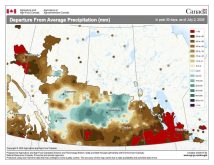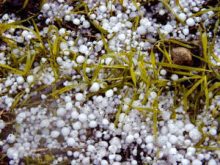Southwest Region
Very little precipitation over the last week, but some localized showers on both sides of the Trans-Canada Highway. Below normal temperatures throughout the week, with hard frosts and some snowfall. Minimum overnight temperature reached -8 C in some parts of the region.
Most seeding done in southern areas, but in northern region is also picking up. Seeding progress during last week was slow. Overall seeding progress estimated at 10 to 15 per cent complete, majority of which are cereals and peas. Very little crop emerged, due to continued cold. Spring wheat is 40 per cent done; peas are 50 per cent done; barley and oats are 25 to 30 per cent complete. Limited acres corn, canola and soybeans planted.
Read Also

June brings drought relief to western Prairies
Farmers on the Canadian Prairies saw more rain in June than they did earlier in the 2025 growing season
Weed emergence is slow but some winter annuals such as dandelion, foxtail barley, and thistles present. Some producers doing pre-seed burnoff between seeding operations.
Winter wheat and fall rye are looking good, but growth is also slow. Top-dress nitrogen is being delayed in some fields due to lack of moisture.
Cool temperatures and forages are slow to regrow. Dugouts, sloughs and streams are below normal for this time of year. Some areas received moisture in the form of snow, will help hay and pastures, but not enough to improve dugout levels. Some cattle are currently on pasture with supplementation.
Northwest Region
Cooler temperatures prevailed this past week with highs in the mid- teens dropping to an average low of -5°C overnight. There was snowfall on the weekend in most areas. Birch River, Minitonas and The Pas received the most precipitation at 10 to 14 mm. These conditions slowed seeding progress throughout the Northwest Region although fields are starting to dry up again and the snow has melted. Soil moisture is generally adequate to normal, drying on the surface with good sub-surface moisture. The exceptions are the area around Ste. Rose/Rorketon where dry conditions remain from last growing season and The Pas where wet conditions from 2018 continue.
In spite of weather, field operations including fertilizer and herbicide applications, tillage and seeding are continuing throughout most of the region. As well, clean up from the previous season’s unharvested crop continues around Swan River, The Pas and Dauphin.
Seeding progressed with 15 to 20 per cent of the peas and 5 to 10 per cent of spring wheat acres seeded. Canola and fababean seeding has started around Swan River this week. Weed emergence and growth including volunteer canola has begun; insect activity is minimal to date.
Minimal new forage growth this past week due to cooler temperatures. Subsoil moisture conditions are good. Dugout levels are adequate but moisture would be welcome around Dauphin. Some cows reported on pastures with supplementation required.
Central Region
The south and western part of the region received snow and light rain early last week putting a stop to field operations. Temperatures remained cold for the first part of the week, delaying field re-entry. The north, central and eastern parts of the region were unaffected and field operations continued. Total precipitation is low across the region with amounts varying from 0 to 7 mm. The Rosenort area and parts of the Red River Valley along Highway 23 received the most precipitation with heavy rainfall at times, some hail, accompanied with powerful wind conditions and a tornado reported. No crop damage reported since crops have not emerged yet.
Daytime temperatures in the low to mid teens, overnight temperatures dipped into the frost range. Daytime sunny conditions mid and late week helped to warm and dry topsoil. Seeding progress expected to pick up momentum, as forecast is favourable for this week.
Seeding progress for spring wheat, oats and barley has advanced the most and reported to range from 35 to 45 per cent complete, but varies across the region. Corn is also going in the ground as conditions allow, with 15 to 25 per cent reported done. Good seeding progress made in the Red River valley but some are just starting on the escarpment where soil conditions were cooler and wetter to start. Indications are of higher cereal acres planted this season. Fertilizer applications progressing along with seeding as conditions considered good at this time.
Canola, flax and sunflower are starting to go in the ground, but cool temperatures and overnight frost conditions are keeping growers from putting too many acres in too early. Potato planting continued in the Winkler-Morden, Portage and Carberry areas at 75 per cent completed.
Peas have been going in the ground with 40 to 50 per cent done. Soybean planting has begun, but more expected this week as soils warm.
Winter annual weeds growing, and summer annuals like kochia, lamb’s quarters and foxtail species are emerging quickly.
Eastern Region
Previous week’s precipitation across the region ranged from 3 to 12 mm of rainfall. Average soil temperatures at seeding depth remains at 80 C. Soil moisture conditions on cropland across rated as adequate to short with northern parts of the region reporting surplus. Soil moisture conditions in hay and pastureland rated as adequate to short.
Northern parts of the region remain wet with producers making some seeding progress on dryer fields. In central and southern areas, good seeding progress made this past week, but cool and periodically wet conditions slowed progress.
Winter wheat stands continue to be assessed for winter damage, with an estimated 5 to 10 per cent of winter wheat acres appear to be dead. No reports of wide spread winterkill. Winter wheat fields appear to be growing slowly with the cool/cloudy weather conditions of the past week.
Overall average spring seeding across the region estimated at 20 per cent complete. Spring wheat estimated at 75 per cent complete, with northern parts of the region having less completed due to wetter soil conditions. In some parts of the region corn planting begun and estimated at 5 per cent complete, with many producers planning to move to corn planting this week. Warmer weather and soil temperatures above 10 C would help with seeding progress and reduce concerns of chilling injury and stressed emergence.
Condition of hay fields rated as fair, while pasture conditions rated at 50 per cent fair to 50 per cent poor. Producers are moving livestock on to pastures and providing supplemental feed. Livestock water availability rated at 100 per cent adequate, while dugouts are at half to three quarters full.
Interlake Region
Cooler temperatures continued, with overnight lows below freezing. Average temperatures for the previous week ranged from 4 to 5 C. Trace rainfall for most areas, with highest amounts of 7 mm at Selkirk.
Seeding continues, with some just starting, while others have spring wheat acres completed. Activity hasn’t been rushed due to cold soil temperatures, but seeding will be general this week. Peas seeding continues, with the majority of acres complete. Canola and oats are starting to go in. Soil moisture is currently adequate, but planned tillage is lower than normal, based on relatively drier conditions. Most progress made in the southern part of the region, but all areas have acres going in.
Fertilization of forage and annual cropland continues. Most forage seed fields fertilized last fall. Winter survival of perennial crops seems to be good, with slow growth under cool temperatures. Weeds are starting to grow; and although some herbicide has been applied, pre-seed burnoff has been a challenge with the below zero temperatures.
Pasture regrowth is slow; it will be some time before cattle moved out. Forage availability is a concern for those impacted most severely by dry conditions last year. Rain and warmer temperatures needed for regrowth. Native hay supplies are at risk due to poor moisture recharge. Dugout levels are below normal, while water supply rated as adequate for the short term.


















